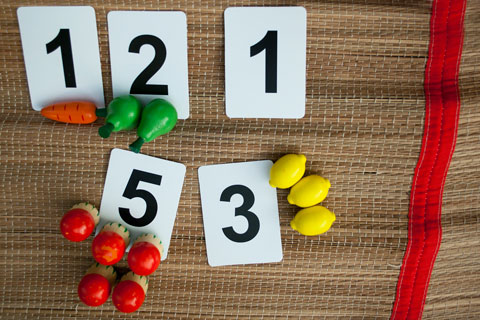Do you know a preschooler who easily solves simple word problems that involve adding and taking away? That child may be ready to apply those math skills to part-to-whole relationship questions and problems that involve comparing sets of objects.
Older preschoolers may be ready for questions about parts and wholes.
- Keep in mind that you may need to explain words such as whole, part, and collection before introducing these word problems.
- You could ask the child to start with the parts of a set or group. For example, you might say, “There are two parts to Min-Yung’s coin collection—4 pennies and 2 dimes. How many coins do you think there are in his whole collection?”
- You can also ask questions that start with a whole set or group. For example, “Min-Yung’s whole coin collection has 6 coins. Four are pennies. The rest are dimes. How many dimes do you think he has?”
- You might ask children to think about splitting up whole items into equal parts. They seem to especially enjoy this activity when food is involved. “Here’s the pizza we made together. How many pieces do you think I should cut so everyone at the table gets a slice?”
Some preschoolers are ready for word problems that compare two sets of objects.
- Before asking children to solve these problems, you may need to explain words like quantity, compare, amount, more, most, fewer, and less.
- You could ask a child to compare quantities. For example, “Winona has 6 pennies and Yusuf has 4. Who do you think has more pennies?” “How many more pennies do you think that person has?”
- When a child can solve problems like this with ease, you can also try reversing the “known” and “unknown” amounts. “Winona has 6 pennies. She has 2 more pennies than Yusuf has. How many do you think Yusuf has?”
- You might want to try comparison problems that have more than one answer. For example, “Yusuf has 4 pennies. Winona has fewer pennies than that. How many pennies could she have?”
Children may enjoy word problems more if they do not feel they must compete to answer the question first.
- If you are working with several children, give them each a chance to reply. Ask each child, “How did you get your answer?” or “What makes you think so?” (The way a child thinks about a problem can be just as important as having a “right” answer.)
- Let children use objects to work out their answers.
- When each child has answered, ask the group to talk about which answer to the problem makes the most sense.
IEL Resource
- Resource List: Math for Preschoolers


 PDF
PDF